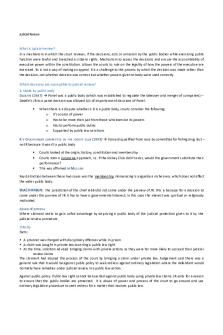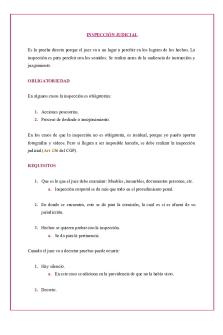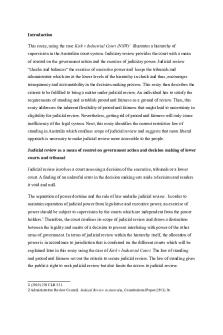JUS-104 - Judical Activism v. Judicial Restraint Final PDF

| Title | JUS-104 - Judical Activism v. Judicial Restraint Final |
|---|---|
| Course | Introduction to Justice Studies |
| Institution | Grand Canyon University |
| Pages | 2 |
| File Size | 92.5 KB |
| File Type | |
| Total Downloads | 111 |
| Total Views | 155 |
Summary
JUS-104...
Description
JUS-104: Judicial Activism v. Judicial Restraint Instructions: Explain judicial activism and judicial restraint in your own words. Read the Supreme Court case summaries and decide whether or not the court followed the philosophy of judicial restraint or judicial activism when making their decision. Judicial Restraint: It asserts that judges should hesitate to strike down laws unless they are obviously unconstitutional, though what counts as obviously unconstitutional is itself a matter of some debate Judicial Activism: an approach to the exercise of judicial review, or a description of a particular judicial decision, in which a judge is generally considered more willing to decide constitutional issues and to invalidate legislative or executive actions
CASE EXAMPLE 1: Brown v. Board of Education Facts of the Case: Black children were denied admission to public schools attended by white children under laws requiring or permitting segregation according to the races. The white and black schools approached equality in terms of buildings, curricula, qualifications, and teacher salaries. Question: Does the segregation of children in public schools solely on the basis of race deprive the minority children of the equal protection of the laws guaranteed by the 14th Amendment? Yes. It does deprive because many young children of a minority because was it is interpreted as a sign of inferiority. The 14th Amendment’s equal protection clause states: “No state shall make or enforce any law…to any person within its jurisdiction the equal protection of the laws.” The Decision: In a unanimous decision (9-0), the Supreme Court decided that the “Separate educational facilities are inherently unequal.” Chief Justice Earl Warren wrote the majority opinion. He wrote, “to separate them [children in grade and high schools] from others of similar age and qualifications solely because of their race generates a feeling of inferiority as to their status in the community that may affect their hearts and minds in a way unlikely to ever be undone.” Do you think that the justices in this case followed the philosophy of judicial restraint or judicial activism? In my opinion, I believe that it was judicial restraint, because it is a decision being decided and that decision was being unconstitutional. Which then requires the judge to take more time to decide and decide whether to create an action for this law and be able to execute it. CASE EXAMPLE 2: Griswold v. Connecticut Facts of the Case: Griswold was the Executive Director of the Planned Parenthood League of Connecticut. Both she and the Medical Director for the League gave information, instruction, and other medical advice to married couples concerning birth control. Griswold and her colleague were convicted under a Connecticut law which criminalized the provision of counseling, and other medical treatment, to married persons for purposes of preventing conception. Question: Does the Constitution protect the right of marital privacy against state restrictions on a couple's ability to be counseled in the use of contraceptives? The Constitution did in fact protect the right of marital privacy against state restrictions on contraception and as well amendment 1, 3, 4 and 9 allows the married couple the right to privacy in martial relations. Conclusion: Though the Constitution does not explicitly protect a general right to privacy, the various guarantees within the Bill of Rights create penumbras, or zones, that establish a right to privacy. Together, the First, Third, Fourth, and Ninth Amendments, create a new constitutional right, the right to privacy in marital relations. The Connecticut statute conflicts with the exercise of this right and is therefore null and void. Do you think that the justices in this case followed the philosophy of judicial restraint or judicial activism? I believe that in this case, judicial activism was used. I say that because more was involved within this case because the judge needs to make a judicial decision and decide whether it will be not on favor for the married couple.
CASE EXAMPLE 3: Marbury v. Madison
Facts of the case: The case began on March 2, 1801, when a Federalist, William Marbury, was designated as a justice of the peace in the District of Columbia. Marbury and several others were appointed to government posts created by Congress in the last days of John Adams's presidency, but these last-minute appointments were never fully finalized. The disgruntled appointees invoked an act of Congress and sued for their jobs in the Supreme Court. Question: Is Marbury entitled to his appointment? Is his lawsuit the correct way to get it? And, is the Supreme Court the place for Marbury to get the relief he requests? Yes he is entitled to his appointment. He is able to approach the Supreme court, however, it is possible for him to go get his request Conclusion: Yes; yes; and it depends. The justices held, through Marshall's forceful argument, that on the last issue the Constitution was "the fundamental and paramount law of the nation" and that "an act of the legislature repugnant [in opposition] to the constitution is void." In other words, when the Constitution--the nation's highest law--conflicts with an act of the legislature, that act is invalid. This case establishes the Supreme Court's power of judicial review. Do you think that the justices in this case followed the philosophy of judicial restraint or judicial activism? I believe that this justice case is judicial activism, because the judge had made a decision bigger than what the government actions can do. The judge is here to be able to decide whether or not it has to be reviewed or make a decision from the case....
Similar Free PDFs

Restraint of trade
- 7 Pages

Restraint of Trade
- 5 Pages

Pan Mayan activism
- 2 Pages

REPORT adnan V final
- 123 Pages

Judicial Review
- 15 Pages

Inspección Judicial
- 4 Pages

Judicial Review
- 50 Pages

Recuperação Judicial
- 5 Pages

AMD-V Hyper-V EULA - Final
- 4 Pages

Judicial Review
- 6 Pages

Judicial Review
- 40 Pages

Judicial Review
- 7 Pages

Judicial-Affidavit
- 5 Pages
Popular Institutions
- Tinajero National High School - Annex
- Politeknik Caltex Riau
- Yokohama City University
- SGT University
- University of Al-Qadisiyah
- Divine Word College of Vigan
- Techniek College Rotterdam
- Universidade de Santiago
- Universiti Teknologi MARA Cawangan Johor Kampus Pasir Gudang
- Poltekkes Kemenkes Yogyakarta
- Baguio City National High School
- Colegio san marcos
- preparatoria uno
- Centro de Bachillerato Tecnológico Industrial y de Servicios No. 107
- Dalian Maritime University
- Quang Trung Secondary School
- Colegio Tecnológico en Informática
- Corporación Regional de Educación Superior
- Grupo CEDVA
- Dar Al Uloom University
- Centro de Estudios Preuniversitarios de la Universidad Nacional de Ingeniería
- 上智大学
- Aakash International School, Nuna Majara
- San Felipe Neri Catholic School
- Kang Chiao International School - New Taipei City
- Misamis Occidental National High School
- Institución Educativa Escuela Normal Juan Ladrilleros
- Kolehiyo ng Pantukan
- Batanes State College
- Instituto Continental
- Sekolah Menengah Kejuruan Kesehatan Kaltara (Tarakan)
- Colegio de La Inmaculada Concepcion - Cebu


